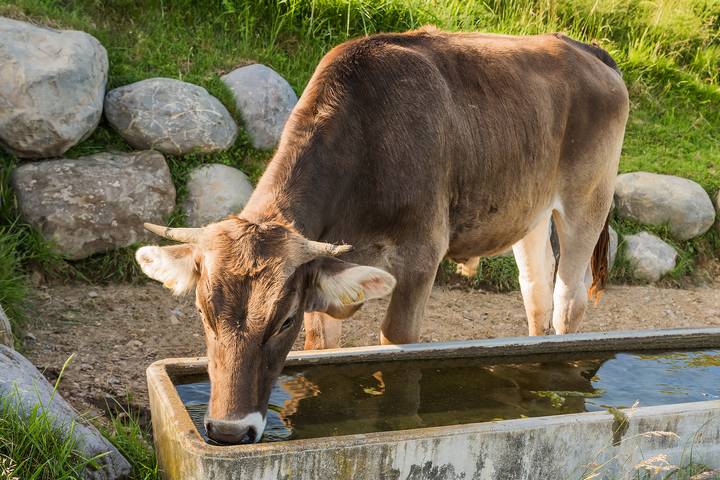
A cattle farm is an opportunity to profit from procuring dairy and beef products, selling calves to other farmers, or for shows at local fairs. How to start a cattle farm is, in part, like running every kind of business. A farmer needs a business plan, land to grow their herd, and start-up financial support. Like in any business, profit is not guaranteed.
A cattle farmer must be smart with their costs and be well-studied on what their cattle needs. Here are the basics of how to start a cattle farm.
1. Write Up a Cattle Farm Business Plan

A cattle farm business plan is key to outlining how you will operate your farm, opportunities to derive profit, and possible threats to profitability. A business plan will also answer important questions, like what kind of cows you want, how much start-up money you will need, and your target market.
2. Define The Type of Cattle Farm You Want

How you will make money on a cattle farm is key. A beef farm is generally more flexible than a cattle farm. That said, if there are local opportunities in the dairy market, this may be something to target.
Dairy cows, however, require a costlier diet to acquire, and they have to be fed and milked simultaneously every day. Either way, beef or dairy cattle farmer will have much to study, learn, and do year-round to keep their herd strong and healthy.
3. Acquire Start-Up Financing for Your Farm

Speak to lenders, banks, and sources that can lend you start-up costs. Be honest and borrow responsibly. Talk to local agricultural and small business organizations about reasonable loans, grants, and subsidies available.
4. Acquire Land to Host Your Cattle Farm On

Search for land for rent or sale to put your cattle farm on. Compare land prices in different areas. Consider buying an existing farm to save on start-up costs.
5. Build Calf Pens and Facilities 5or Cattle

No matter your cattle farm type, your cows require calf pens, a barn for shelter when not out to pasture, and other facilities. Calf pens, in particular, are necessary for any farm with calves on them. They should be individual, hygienic, easy to clean, and comfortable for the calf.
6. Install a Water Source

Cattle drink a large amount of water every day. To keep your cows hydrated, a cattle waterer is a start. The pastures also have to be kept green, so, at the same time, an irrigation system is very advantageous. A pond or reservoir on the property can also help ensure everything stays hydrated.
6. Provide Your Cows with Enough Space

Cattle require a lot of land. A lack of land may mean cows eating pastures until they are ruined. A cow will require at least 1 acre each. If you intend to have cow/calf pairs, the minimum amount of pasture to set aside is 2 acres.
7. Closely Evaluate Land You May Buy

Research land you are considering starting a farm on. Discover what it was previously used for. Understand what kind of soil is there and what vegetation grows there. Make sure it’s suitable for a pasture. Talk to the neighbours about the land, if you can.
8. Select the Right Cattle Breed

There are more than 100 cattle breeds globally, each with pros and cons. A docile breed like Herefords or Shorthorns is best if your cattle farm is for beef production. Black Angus is a great pick for beef; however, it is an aggressive breed and not ideal for beginners. For dairy, Holstein, Jersey, or Brown Swiss are among the ideal breeds to look at.
9. Start Small With Five Cows Or Less

Most start-up farmers purchase 1-3 cows for a small farm. Any more than five cows and a farmer runs a major financial risk. A cattle farmer needs to know how to keep cows healthy before understanding how to derive profit from their activities.
11. Plant Grass And Alfalfa

Seed pasture with grass and alfalfa to eventually make hay from. Hay forms the basis of a cattle’s diet and is fed corn and grains.
12. Purchase Cattle Farm Equipment

Depending on what type of cattle farm you operate, you may require specialized equipment, such as a milking machine or stanchion.
13. Set Up Fences to Keep Cattle Contained

You don’t want cattle wandering off the farm. Cattle can destroy fences if they are improperly installed. Ensure your fences are professionally put in with fence posts 16.5 inches apart. Connect them with electrified, high-tensile wires, and set them up around your perimeter and any other areas you want to protect from cattle access.
14. Sell Products Locally to Start

Many local opportunities exist to sell farm products, such as farmer’s markets and local business partners that can stock your product. Look for local selling opportunities where you don’t need to invest in significant transportation to another region.
